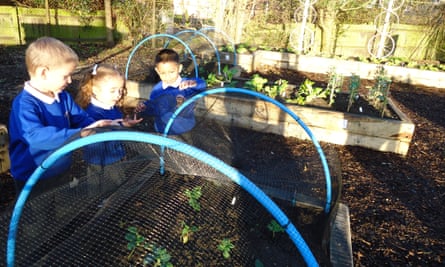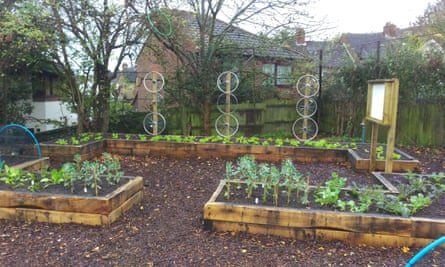Source: theguardian.com
Published: April 5, 2016

Edible gardens help teach children about nutrition, encourage physical activity, and they can help with food poverty. Photograph: Rockmount primary school
Schools are discovering that getting students to grow their own greens has benefits beyond healthy eating and unusual learning opportunities
How can we get children to eat more vegetables? There’s no shortage of advice on the matter, varying from “serve them with unpopular foods” to “act more like French people” or “just give up”. But schools are discovering that getting students to grow their own greens can make a big difference. This hands-on method is so powerful, in fact, that it can even detoxify the dinner table nemesis of generations: the brussel sprout.
“We had a group of children who were so excited about eating brussels sprouts last Christmas because they had harvested them,” says Helen Carvall, headteacher of Rockmount primary school in Croydon. “They harvested a load of chard too, and made posters saying ‘Glorious chard!’ which they put up in the dining room. They were encouraging the other children, saying: ‘Eat this! We grew it!’”

Raised beds at Rockmount primary school. Photograph: Rockmount primary school
The school had already launched a popular gardening club and been designated as a “food flagship school” (committing to lower levels of sugar, salt and fat in its meals) when Carvall decided to create an edible playground. Working with the charity Trees for Cities, they transformed a little-used sensory garden into an allotment growing rhubarb, berries, beans, onions, chard, potatoes and apples. The first planting finished in January and Trees for Cities will now work with the school for the rest of the academic year to support growing and teaching.
Edible playgrounds are springing up across the country and address several key areas of concern around children’s health. They teach pupils about nutrition, encourage physical activity, and can help with food poverty. They are also a much-needed source of fresh produce in “food deserts” – areas where it is a struggle to find healthy, affordable produce. It’s an issue that Stephen Ritz, the US-based advocate for the movement, knows only too well. In his area of the Bronx, New York, he says, “it’s easier to get liquor than a lettuce”.
Ritz’s in-school agriculture began by accident with a pack of seeds behind a heater in 2009. It has since expanded into Green Bronx Machine, a nationwide project helping other schools to start their own green programmes, and a TED talk that has been viewed almost a million times. At this point, Ritz’s students have grown 35,000lbs of vegetables. But the trick, he says, is to get the basics right first.
“You’ve got to start small,” he advises. “Start small, celebrate often. Let the kids run the ship, or at least let them think that they do. Be a benevolent dictator. Grow the things that they like, or the things that are important to their parents and grandparents. Ask questions. Start discussions.”
Carvall also says that talking about food has been a major benefit of the edible playground. “My co-head and I eat in the dining hall every day and the conversations are so food-centred now, like they’ve never been before,” she explains.
Just as important, however, are conversations with staff, who will naturally have differing levels of knowledge about planting, harvesting and even about vegetables. It’s also vital to train teachers how to integrate the garden into their lessons in a way that is meaningful, rather than a tokenistic “Oh look, a courgette” exercise.
Kate Sheldon, development director of Trees for Cities, says the possibilities are enormous. “Obviously a garden works for lessons on healthy eating, growing food and so on,” she explains, “but it’s also a teaching resource to use across the entire curriculum. For example, maths can be taken outside to measure yield and the dimensions of raised beds.”
Carvall decided to employ an edible playground coordinator to oversee the project. As well as maintaining the plots and the massive spreadsheet projecting the growth schedule for the year, the coordinator works closely with teachers to help them plan lessons that make full use of the garden’s potential.
Cassie Liversidge of Grow Your Own Playground takes a different approach in the seven schools she works with. Instead of assisting teachers in planning garden lessons, she creates them herself (in line with the topic being studied), allowing the adults to get stuck in too.
“We do quite exciting things, so it does require quite a lot of planning,” she explains. “The teachers often don’t have the time or knowledge to plan it themselves. Plus it’s a really good opportunity for them to see how their pupils work. They get totally involved.”
Her lessons also go beyond healthy eating, with recent examples including a session on how flax is used to make clothes, and a long-term project on wheat that ended with each pupil baking their own loaf of bread.
Edible playgrounds can have positive effects beyond the school grounds, particularly when it comes to encouraging enterprise. St Paul’s school in Whitechapel has links with a local chef, who buys the surplus produce from the garden, and Trees for Cities works with School Food Matters, which helps their partner schools take produce to market.
Gardens have also been used to aid transition between primary and secondary school, Sheldon says, offering younger pupils a place to meet their future peers while working on a shared project.
Carvall says that as her school’s edible playground grows, she will bring in parents, carers and other members of the community to maintain and enjoy it. In the meantime, she and her staff are working with families and school caterers to ensure that healthy living is woven into life at home and at school.
“This isn’t a little decorative garden in the corner of the playground,” she says. “It’s something which is active, and there to use. It has to become part of the ethos; it has to fit with your school identity.”
And Ritz says the finest product of all your hard work will be something greater than potatoes and chard. “Seeds represent genetic potential and the kids are my seeds,” he laughs. “My favourite crop ever is organically grown citizens.”
